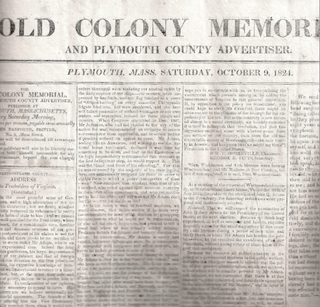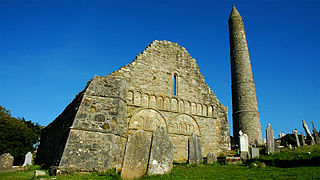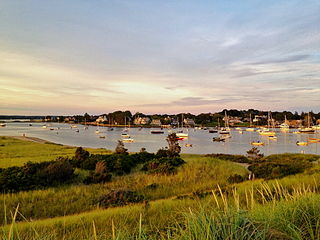The Mayflower Inn on Manomet Point, Plymouth Massachusetts was a large wooden structure set atop a hill off Point Road, with sweeping vistas of White Horse Beach to the north and the Cape Cod Bay and Scooks Pond to the south. Its exterior is similar in design to the Chatham Bars Inn, located in Chatham Massachusetts, which opened in 1914.

Plymouth is a town in Plymouth County, Massachusetts. The town holds a place of great prominence in American history, folklore, and culture, and is known as "America's Hometown." Plymouth was the site of the colony founded in 1620 by the Mayflower Pilgrims, where New England was first established. It is the oldest municipality in New England and one of the oldest in the United States. The town has served as the location of several prominent events, one of the more notable being the First Thanksgiving feast. Plymouth served as the capital of Plymouth Colony from its founding in 1620 until the colony's merger with the Massachusetts Bay Colony in 1691. It is named after Plymouth, England where the Mayflower set sail for America.

Massachusetts, officially the Commonwealth of Massachusetts, is the most populous state in the New England region of the northeastern United States. It borders on the Atlantic Ocean to the east, the states of Connecticut and Rhode Island to the south, New Hampshire and Vermont to the north, and New York to the west. The state is named after the Massachusett tribe, which once inhabited the east side of the area, and is one of the original thirteen states. The capital of Massachusetts is Boston, which is also the most populous city in New England. Over 80% of Massachusetts' population lives in the Greater Boston metropolitan area, a region influential upon American history, academia, and industry. Originally dependent on agriculture, fishing and trade, Massachusetts was transformed into a manufacturing center during the Industrial Revolution. During the 20th century, Massachusetts's economy shifted from manufacturing to services. Modern Massachusetts is a global leader in biotechnology, engineering, higher education, finance, and maritime trade.

Cape Cod Bay is a large bay of the Atlantic Ocean adjacent to the U.S. state of Massachusetts. Measuring 604 square miles (1,560 km2) below a line drawn from Brant Rock in Marshfield to Race Point in Provincetown, Massachusetts, it is enclosed by Cape Cod to the south and east, and Plymouth County, Massachusetts, to the west. To the north of Cape Cod Bay lie Massachusetts Bay and the Atlantic Ocean. Cape Cod Bay is the southernmost extremity of the Gulf of Maine. Cape Cod Bay is one of the bays adjacent to Massachusetts that give it the name Bay State. The others are Narragansett Bay, Buzzards Bay, and Massachusetts Bay.
The Mayflower Inn opened in June 1917. "This ambitious 170-room (including outbuildings) Colonial Revival-style structure was designed by Boston architect J. Williams Beal ...," Bryant Tolles wrote in Summer By the Seaside: The Architecture of New England Coastal Resort Hotels. It included "a low, 260-foot-long three-story gambrel-roof edifice, highlighted by its expansive shed-roof dormers, paired front gambrel bays, and extended veranda with balustrades." [1]

John Williams Beal was an architect in Boston, Massachusetts.
This inn was a summer resort for wealthy Americans, New England Governors Conventions and politicians.

New England is a region composed of six states in the northeastern United States: Maine, Vermont, New Hampshire, Massachusetts, Rhode Island, and Connecticut. It is bordered by the state of New York to the west and by the Canadian provinces of New Brunswick to the northeast and Quebec to the north. The Atlantic Ocean is to the east and southeast, and Long Island Sound is to the south. Boston is New England's largest city, as well as the capital of Massachusetts. Greater Boston is the largest metropolitan area, with nearly a third of New England's population; this area includes Worcester, Massachusetts, Manchester, New Hampshire, and Providence, Rhode Island.
The inn was built near the historic Ardmore Inn, formerly the Manomet House, founded in the 18th century and run for generations by members of the Holmes family. [2] "When the Mayflower Hotel was built in 1917, the Ardmore Inn was used to house the help and personnel. When I was a child, it was used for this purpose and through the years, lapsed into a state of disrepair," Muriel Holmes Anderson Weeks wrote in A Family History in 1975. The Ardmore was demolished in the 1960s, despite local efforts to preserve it.
In its heyday the Mayflower Inn, "attracted a New York clientele and dominated life along the shoreline in 1950s," according to The Old Colony Memorial newspaper. [3]

The Old Colony Memorial (est.1822) is a semiweekly newspaper published in Plymouth, Massachusetts. GateHouse Media owns the paper; previous owners include the George W. Prescott Publishing Co. and the Memorial Press Group.
They really catered to wealthy people ... They owned all the cottages along Taylor Avenue and had a shore club and annex. The people would all eat at the main hotel and a lot of the women would even have fur coats on and this was in the summer. They even had an amphibious plane that would fly people in. It would run right up on the beach.
The mighty hotel fell on hard times as resorts in the Catskills gained in popularity in the 1960s.
The structure was significantly damaged by sequential fires in the 1970s. It was eventually demolished and replaced by a condominium complex.














